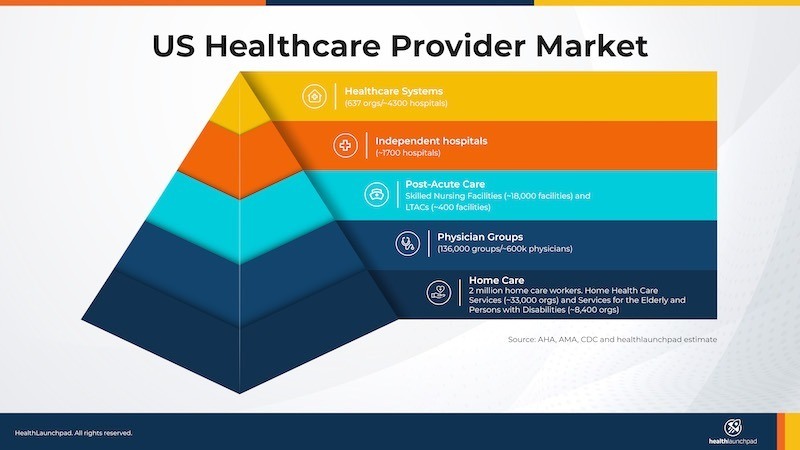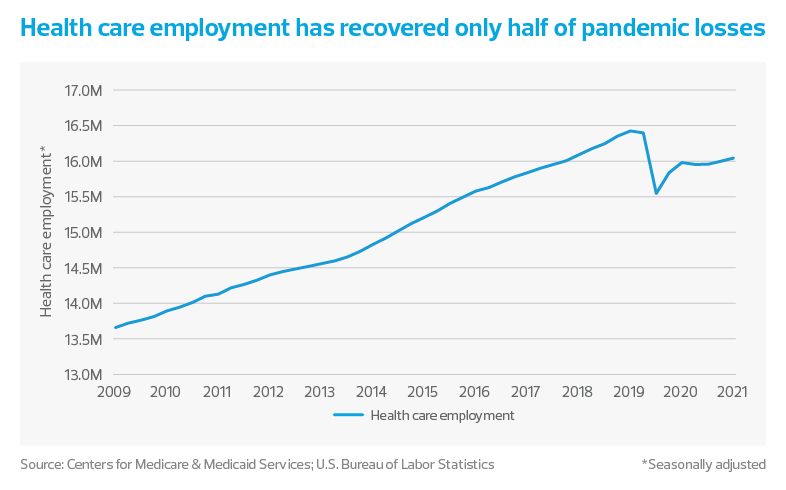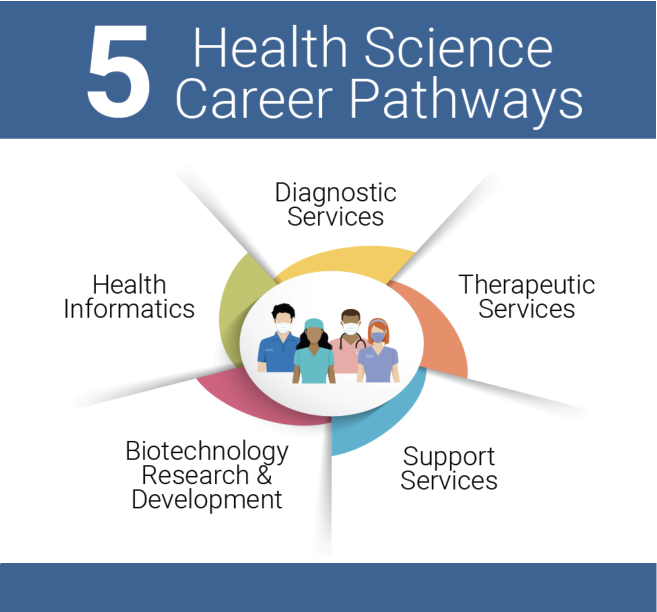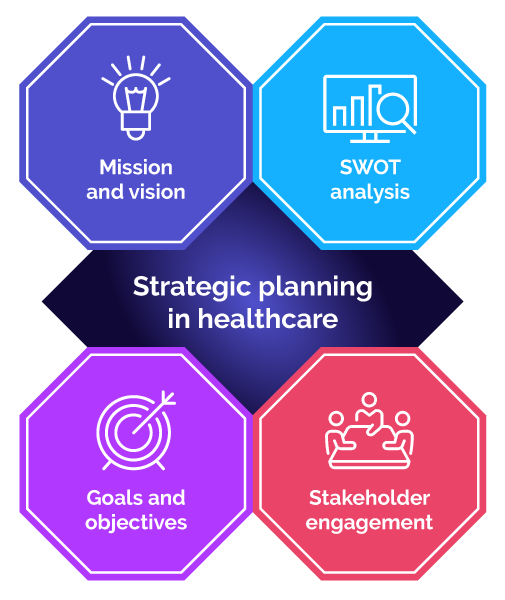Understanding the Healthcare Sector’s Role and Future Outlook
The healthcare sector is a pivotal component of the U.S. economy, crucial for addressing the needs of an aging population while integrating technological advancements. Recent projections suggest that healthcare jobs will grow significantly faster than other sectors over the next decade, underscoring its expanding influence and necessity.

Image source: Source
Technological advancements such as artificial intelligence and digital health technologies are reshaping healthcare, streamlining operations, enhancing patient care, and creating new career opportunities. However, these changes also prompt questions about the future workforce structure and necessary skills for success in this evolving environment.

Image source: Source
The rising demand for healthcare services, driven by an increase in chronic diseases and an aging population, highlights the need for strategic workforce planning. The sector is not only expanding its workforce but also enhancing existing roles to ensure a more efficient and responsive healthcare system.

Image source: Source
Looking ahead, the healthcare sector’s future is one of adaptation and resilience, becoming increasingly integral to the nation’s economic and social fabric. The interplay between technology and healthcare promises a more personalized and accessible care delivery. As these advancements unfold, stakeholders must navigate the evolving landscape with foresight, ensuring the workforce is prepared for the challenges and opportunities ahead.
For detailed projections and ongoing updates, refer to the Bureau of Labor Statistics’ Economic Projections.
Explore the Current Landscape of Healthcare Occupations
The current landscape of healthcare occupations in the U.S. showcases a remarkable diversity and resilience, highlighting the sector’s critical role in national employment. With roles ranging from nurses and doctors to allied health professionals, healthcare remains a major contributor to job growth. Notably, healthcare employment has increased by 5.7% since February 2020, underscoring its robust nature despite global economic uncertainties.

Image source: Source
A significant trend is the substantial rise in job openings within the healthcare and social assistance sectors, which surged by 48% from 2019 to 2023. This growth underscores the sector’s adaptability and its crucial role in addressing the evolving health needs of the population. The demand for healthcare workers is driven by demographic shifts, such as an aging population, and increased access to healthcare services, facilitated by policy changes and technological advancements.
The healthcare sector encompasses a wide range of occupations, each playing a vital role in patient care, administration, and medical technology. Positions like physical therapists, pharmacists, medical assistants, and health information technologists contribute uniquely to patient care and the overall healthcare delivery process.
As the sector evolves, so does its workforce. The integration of technology into healthcare practices is creating new roles and transforming existing ones, requiring a workforce that is adaptable and skilled in both traditional care methods and modern technological applications. This dynamic environment presents opportunities and challenges for healthcare professionals, emphasizing the need for continuous education and training.
Understanding these trends is crucial for stakeholders, including policymakers, educational institutions, and healthcare organizations. Strategic planning and investment in workforce development are essential to ensure the healthcare sector can continue to thrive and meet the demands of a growing and changing population.
For more detailed insights into the recent trends in health sector employment, readers can refer to the Peterson-KFF Health System Tracker.
Discover What’s Driving Growth in Healthcare Jobs
As the U.S. healthcare landscape evolves, several key factors are driving the surge in job opportunities within this vital sector. A significant force behind this growth is the demographic shift towards an aging population. As people live longer, the demand for healthcare services inevitably rises, necessitating more healthcare professionals to cater to this growing need. This trend is compounded by improved access to healthcare services, facilitated by policy changes and technological innovations, ensuring that more individuals can receive the care they require.
Technological advancements are reshaping the healthcare industry, enhancing the efficiency and effectiveness of care delivery. Innovations such as telemedicine, electronic health records, and AI-driven diagnostic tools are not only improving patient outcomes but also creating new roles and specialties within the healthcare field. These technologies demand a workforce skilled in both traditional healthcare practices and modern technological applications, further expanding job opportunities. For instance, the rise of telehealth has led to increased demand for professionals adept at remote patient monitoring and virtual consultations.

Image source: Source
Moreover, there is a growing need for professionals in behavioral health and substance use disorder services. As awareness and understanding of mental health issues grow, so does the demand for qualified professionals to address these challenges. This expansion in professional demand highlights a critical area within healthcare where growth is both necessary and inevitable.
These factors collectively underscore the dynamic and expanding nature of the healthcare workforce. For those considering a career in healthcare, these trends offer promising prospects and the potential for meaningful contributions in a sector that is both rewarding and essential to societal well-being. According to one study by the Bureau of Labor Statistics, healthcare jobs are expected to grow significantly over the next decade.
Unpack the Projected Job Outlook for Healthcare
The future of healthcare employment in the U.S. looks promising, with projections indicating the addition of approximately 6.7 million jobs over the next decade. This surge is largely driven by roles like nurse practitioners and medical and health services managers, both expected to experience a remarkable 29% growth rate. Such expansion underscores the sector’s responsiveness to an aging population and the increasing complexity of healthcare delivery systems.
While these figures are encouraging, they also highlight the importance of strategic workforce planning. Economic factors, such as fluctuating healthcare costs and insurance coverage changes, will significantly impact these projections. Policy shifts, including healthcare reform and funding adjustments, could either bolster or hinder this expected growth. Addressing these variables requires a proactive approach from healthcare institutions and policymakers alike.
The anticipated job growth is not uniform across all healthcare professions. Recognizing which sectors are poised for expansion, such as roles in preventive care and digital health, can guide educational institutions and training programs in tailoring their curriculums to meet future demands. This alignment will be crucial in ensuring that the workforce is adequately prepared to fill these roles.
As stakeholders consider these projections, they must remain adaptable, ready to pivot in response to unforeseen economic and policy changes. By doing so, the healthcare sector can continue to thrive, providing essential services to meet the needs of a growing and diverse population.
For more detailed information on these projections, refer to the Occupational Outlook Handbook.
Address Challenges Facing the Healthcare Workforce
The U.S. healthcare sector is grappling with a looming workforce shortage that poses a significant threat to its capacity to meet growing demands. In 2022 it was predicted the nation could face a deficit of 200,000 to 450,000 registered nurses by this year (see stats on current shortage), exacerbated by an aging workforce and increased healthcare needs. The physician shortfall is equally alarming, with projections indicating a gap of up to 124,000 doctors by 2033. These figures highlight a pressing need for strategic interventions in workforce planning and educational innovations according to a report by the AAMC.
To address these challenges, the healthcare industry must adopt multifaceted approaches. Enhancing educational pathways is critical; this includes expanding nursing programs and medical residencies and offering flexible learning models to attract diverse candidates. Technology can play a pivotal role, not only in training through virtual simulations but also in practice, by enabling healthcare professionals to operate more efficiently.
Moreover, workforce retention strategies need prioritization. This involves improving working conditions, providing competitive compensation, and offering career advancement opportunities. By fostering supportive environments and recognizing the value of healthcare workers, the sector can mitigate burnout and turnover, which are prevalent issues.
Importantly, innovative workforce strategies must also consider the integration of international healthcare professionals. Streamlining the credentialing and immigration processes could serve as a viable solution to bridge immediate shortages while long-term domestic training pipelines are developed. This approach requires policy adjustments and collaborative efforts between government bodies and healthcare institutions.
As we navigate these challenges, how can the healthcare sector continue to provide quality care while adapting to the evolving landscape? The answers may lie in embracing innovative strategies and leveraging global talent to sustain the workforce.
Embrace the Impact of Technology on Healthcare Jobs
The healthcare sector is at the forefront of a technological revolution, with AI and digital health reshaping the landscape of healthcare jobs. This transformation is not about replacing human effort but enhancing it, introducing efficiencies that were once unimaginable. As AI algorithms and tools like telemedicine become integral to healthcare delivery, professionals are finding new ways to augment their expertise with technology, leading to roles that blend clinical acumen with technical skills.

Image source: Source
Artificial intelligence plays a pivotal role in diagnostics and patient care management. AI systems can analyze vast amounts of medical data far quicker than any human, identifying patterns that contribute to early diagnosis and personalized treatment plans. This allows healthcare professionals to focus more on patient interaction and decision-making, while AI manages the data-heavy tasks. This synergy between human intelligence and machine learning is paving the way for hybrid roles such as clinical informaticists and health data analysts, which require an understanding of both healthcare and technology.
Beyond redefining existing roles, technology is creating new career paths. The rise of digital health platforms has increased demand for digital health strategists, cybersecurity experts, and AI specialists within healthcare settings. These roles support the integration of new technologies into healthcare systems, ensuring they are secure, efficient, and beneficial to patient care. As healthcare systems globally strive to become more data-driven, professionals with the skills to manage and interpret this data are in high demand.
However, the integration of technology into healthcare is not without challenges. How do we maintain the human touch essential in healthcare? Will automation lead to job displacement, or will it serve as a catalyst for job evolution? These questions encourage a critical examination of how technology can be leveraged responsibly to enhance—not replace—the human elements of care.
The future of healthcare jobs lies in balancing technological innovation and the irreplaceable human touch. Embracing these advancements requires a proactive approach, ensuring that the healthcare workforce is equipped with the skills necessary to thrive in an increasingly digital world. As we navigate this exciting frontier, technology’s role in healthcare jobs promises not only to redefine our current understanding but also to expand the horizons of what is possible in patient care and healthcare delivery.
For more insights on this transformative journey, consider exploring The Impact of AI on the Healthcare Workforce: Balancing Opportunities and Challenges.
State-by-State Healthcare Job Trends: Navigating Regional Opportunities
The landscape of healthcare employment across the United States is as diverse as its geography. Job growth rates vary significantly from one state to another, largely influenced by local policies, demographic shifts, and economic conditions. Understanding these nuances is essential for effective workforce planning and development.

Image source: Source
States with aging populations, such as Florida and Arizona, are experiencing a surge in demand for healthcare services, creating more job opportunities in geriatrics and home healthcare. Conversely, states with younger demographics focus on pediatric care and preventive health services. This demographic-driven demand requires a tailored approach to healthcare education and resource allocation.
Local policies are also pivotal. States that have expanded Medicaid under the Affordable Care Act generally see greater job growth in the healthcare sector. This expansion increases access to healthcare services, driving up the need for healthcare professionals. In contrast, states that have not expanded Medicaid may face challenges like limited access to care and workforce shortages.
Economic factors, such as state GDP growth and unemployment rates, further influence healthcare job trends. States with robust economies can invest more in healthcare infrastructure, leading to job creation and talent attraction. Conversely, states facing economic difficulties may struggle with resource allocation, negatively impacting job growth.
Understanding these state-by-state differences is crucial for healthcare professionals planning their careers and policymakers aiming to optimize health outcomes and economic efficiency. Targeted workforce development strategies, informed by these regional insights, can address specific state needs, ensuring a more balanced and effective healthcare system nationwide.
Navigate Career Opportunities in Healthcare
The healthcare sector is a dynamic field offering a multitude of career paths tailored to a variety of interests and skills. From the hands-on care provided by nurses and physicians to the strategic management roles assumed by health services managers, the sector is rich with possibilities. When choosing a career in healthcare, several factors come into play, such as salary, work-life balance, and growth potential. These elements not only influence one’s career path but also affect overall job satisfaction.

Image source: Source
For those considering a career in healthcare, resources like the U.S. News Best Health Care Jobs rankings are invaluable. These rankings provide insights into job satisfaction, salary expectations, and educational requirements, aiding individuals in making informed decisions about their careers. High-demand roles like nurse practitioners and medical and health services managers stand out for their promising growth and rewarding prospects. Explore the Best Health Care Jobs.
As the healthcare landscape evolves with technological advancements and demographic shifts, the demand for skilled professionals in both clinical and administrative roles is expected to rise. Prospective healthcare workers should consider not only the current job market but also future trends and innovations that could redefine the sector. By leveraging available resources and staying informed about industry developments, individuals can effectively navigate the complex healthcare job market, positioning themselves for long-term success.
Strategic Planning for Future Challenges
The rapidly evolving landscape of the U.S. healthcare sector necessitates strategic foresight and innovative solutions. As the sector expands due to demographic shifts and technological advancements, stakeholders must engage proactively to ensure a robust and responsive workforce. The challenges of workforce shortages and the integration of specific technologies like AI-driven diagnostics and robot-assisted surgeries into healthcare practices require a multifaceted approach to workforce planning.

Image source: Source
Strategic planning should focus on recruiting and retaining a diverse and skilled workforce while integrating cutting-edge technologies that redefine healthcare roles. This effort requires collaboration across education, policy-making, and industry leadership to develop sustainable strategies that can meet future demands. For instance, a successful case study involves a healthcare system that integrated AI-driven diagnostics, which enhanced efficiency and allowed healthcare professionals to focus on more complex tasks.
Speculatively, what innovative strategies could healthcare leaders adopt to mitigate workforce shortages? By addressing such questions, stakeholders can craft a healthcare system that not only adapts to but thrives amidst the complexities of a dynamic future.
For detailed insights on healthcare workforce projections, visit the Occupational Outlook Handbook.
